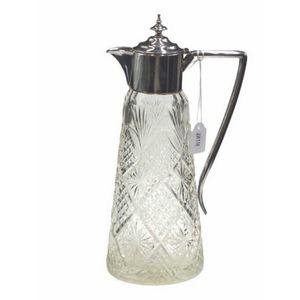
Vintage silver plated cut crystal claret jug with handle
Vintage silver plated cut crystal claret jug silver plated collar and handle, to cut crystal jug, height 29 cm.

Cut glass claret jugs with silver plated mounts, star decorations
An attractive pair of late Vict/Edward cut glass claret jugs, silver plated mounts, the hinged lids with pierced thumbpiece and engraved monogram, the bodies with engraved allover star decorations and hobnail band below, 24 cm high

Renaissance Style Silver Plated Crystal Wine Ewer with Mask Spout
A Renaissance style silver plated and etched and cut crystal wine ewer, with mask head spout and hinged lid, the flat circular crystal body etched with shields and scrolling foliage. Height 41 cm.

Victorian silver plate claret jug with blue glass finial
A late Victorian silver plate claret jug with blue cut glass finial stopper
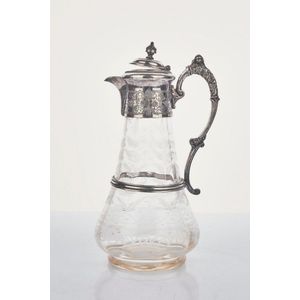
19th Century English Etched Glass and Silver Wine Jug
An etched glass and silver-plated wine jug, English 19th century, 30 cm high

Victorian Etched Crystal Claret Jug with Silverplate Lid, 29cm
Victorian etched crystal claret jug, finely etched with silverplate embossed lid and handle, height 29 cm

English cut crystal claret jug with silver plated mounts, 19th/20th century
An English cut crystal claret jug with silver plated mounts by James Dixon & Sons, 19th/20th century, 23 cm high

Victorian Silver Plate Claret Jug with Elkington & Co Mark
A Victorian silver plate mounted claret jug, Elkington & Co, circa 1890, the compressed ovoid body with etched vine and leaf decoration and an angular leaf capped handle, the collar decorated with applied floriate and mask head mounts, and surmounted by a…

Edwardian Claret Jug with Cut Crystal and Silverplate Decoration
Edwardian claret jug, cut crystal and silverplate scroll decorated spout and handle, height 30 cm

USA Silverplated and Cut Crystal Whitehill Claret Jug - Superb Quality
Whitehill claret jug, superb quality USA silverplated and cut crystal claret jug
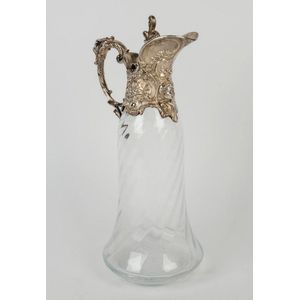
19th/20th Century Antique Claret Jug with Silver Plated Mounts
An antique claret jug with silver plated mounts, 19th/20th century, 33 cm high
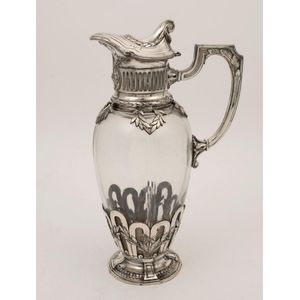
Antique German Silver Plated Claret Jug, Circa 1900
W.M.F. German silver plated claret jug, circa 1900, 27 cm high

19th Century Ruby Crystal Claret Jug with Silver Mounts
An antique cut ruby crystal claret jug with silver plated mounts, 19th century, 28 cm high
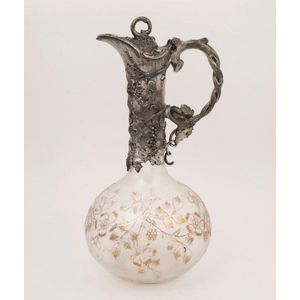
19th Century English Claret Jug with Butterfly Floral Etching
An antique English claret jug with silver plated mounts and acid etched cameo butterfly and floral decoration with remains of gilded highlights, 19th century, 31 cm high
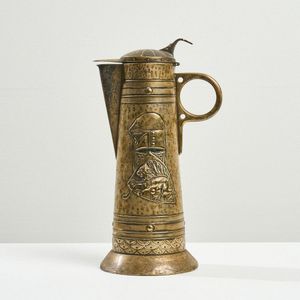
WMF German Art Nouveau Silver-Plate Claret Jug with Lion
A WMF German Arts & Crafts Art Nouveau Silver-Plate hammered claret jug, 1910. With sunken designs and raised relief of a lion. Height 35 cm, width 19 cm, depth 14.5 cm, Provenance: this piece was one of the first collected by Ross at the age of 13.
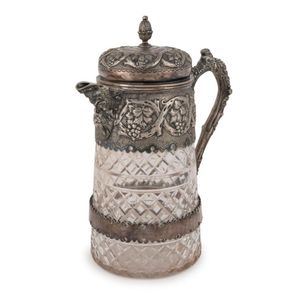
19th Century Continental Crystal Claret Jug with Silver Mounts
A Continental crystal claret jug with silver plated mounts, 19th century, 29 cm high
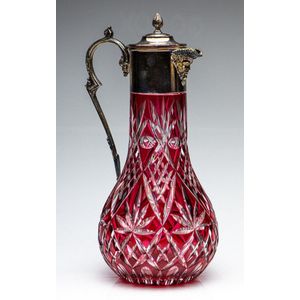
Ruby Crystal Claret Jug: Hand Cut Elegance at 33cm
A ruby coloured hand cut lead crystal claret jug height 33 cm
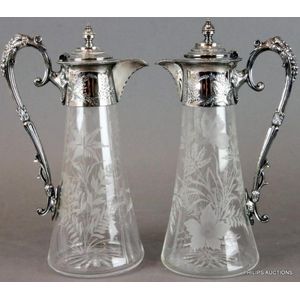
Victorian Silver Plate Claret Jugs with Fern Etching (10 words)
A pair of Victorian silver plate mounted claret jugs, circa 1870, the fine tapering glass jugs, each with etched fern decoration and star cut to the base, with long scrolled handles, pourers and lids decorated with foliage and fruit, marked 16161 inside…
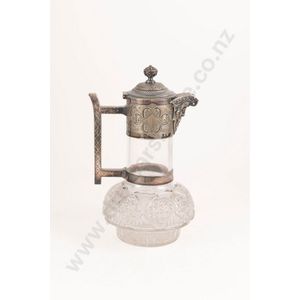
Hukin & Heath Cut Crystal Claret Jug
Cut crystal silver plated claret jug by Hukin & Heath, the footed and domed body with hobnail and star cut panels, s/p handle and mount with bearded mask spout
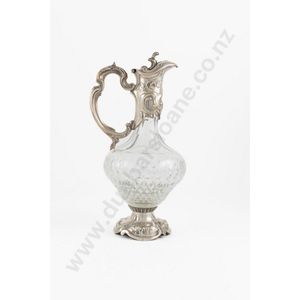
French Crystal Claret Jug with Rococo Handle
Elegant French cut crystal claret jug, baluster shape with faceted decorations and s/p rococo handle, mount and base
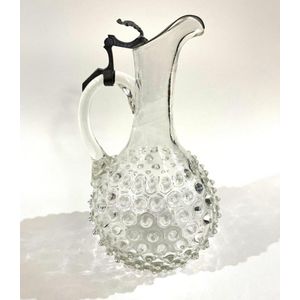
Victorian Hobb Nail Glass & Pewter Wine Ewer
A Victorian Hobb nail glass & pewter wine ewer c. 1890, height 26 cm

English Cut Crystal Claret Jug with Rococo Style Mounts
An English cut crystal claret jug with silver plated mounts in the rococo style, 20th century, 28 cm high
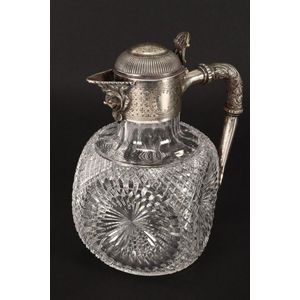
Victorian Silver-Plated Claret Jug with Cut Crystal Body
Handsome Victorian claret jug, with silver plate cover, mount and handle, set above a dimpled cut crystal body, height 20.5 cm
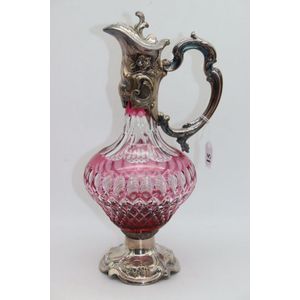
Ruby Overlay Claret Jug with Silver Plated Lid
Whitehill claret jug, ruby overlay and cut design, silver plated base and lid with hinged cover
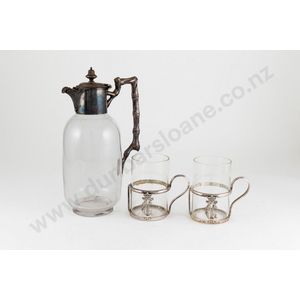
Antique Glass Claret Jug with Silverplate Bamboo Handle and Cups
Antique glass claret jug, with silverplate naturalistic bamboo form handle and a pair of glass drinking cups by Norbliniska, Poland, the s/p holders with crowned monogram
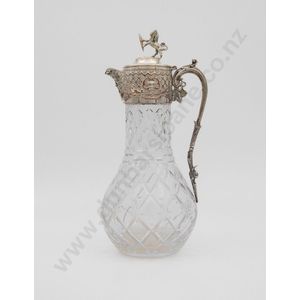
Crystal Claret Jug with Silverplate Mount and Lion Finial
A cut crystal claret jug, with silverplate mount, hinged lid with lion and shield finial
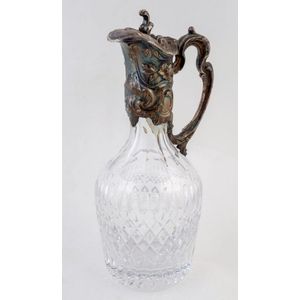
Whitehill Crystal Claret Jug with Silver Mounts, 20th Century
Whitehill English crystal claret jug with silver plated mounts, 20th century, 29 cm high
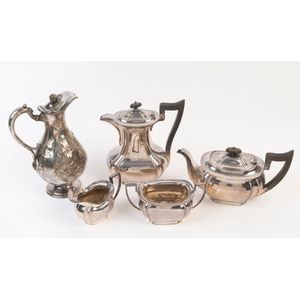
Silver Tea Set and Claret Jug Collection
A silver plated four piece tea service and an antique silver plated claret jug, 19th and 20th century, (5 items), the largest 25 cm high
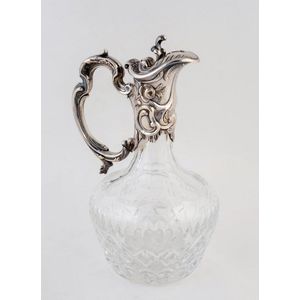
English Claret Jug with Silver Plate, 20th Century
Whitehill English claret jug with silver plated mount, 20th century, 26 cm high
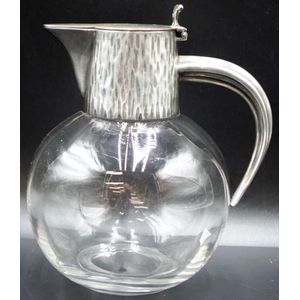
Bark Finish Silver Plate Claret Jug - 16.5 cm High
Hukin & Heath silver plate claret jug with bark finish 16.5 cm high
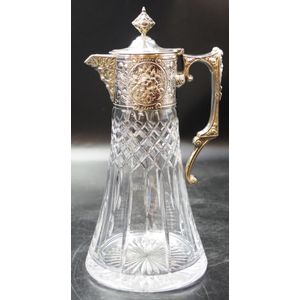
Embossed Silver Plate & Crystal Claret Jug with Bacchus Spout
Good vintage silver plate & crystal claret jug embossed decoration to silver plate cover and handle, Bacchus mask head decoration to spout, to cut crystal claret jug, height 28 cm.
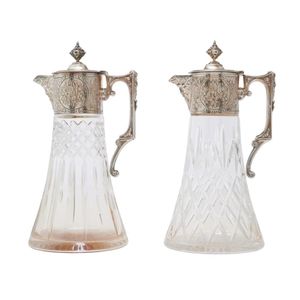
Matched crystal claret jugs with silver plate mounts
A matched pair of silver plate mounted cut crystal claret jugs, each of identical spreading form with identical mounts, but differneces in the cutting. Of cylindrical tapered form, the embossed and chased silverplate collars, with hinged covers and…
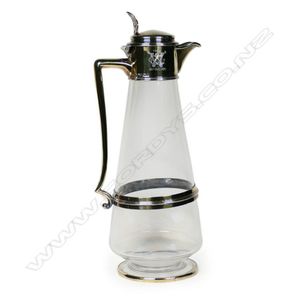
Victorian Silver Claret Jug with Engraved Crest
A Victorian silver and glass claret jug, tapering form, silver rim to base, the long handled attached to silver band to the body, the collar with engraved crest and initials, all the silver with original gilding, Sheffield 1872 by William & George Sissons…
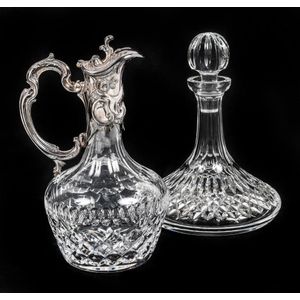
Crystal Decanter and Claret Jug Set
A Waterford 'Lismore' cut crystal ships decanter and a crystal Whitehill claret jug with silver plated mounts, the largest decanter 25 cm high
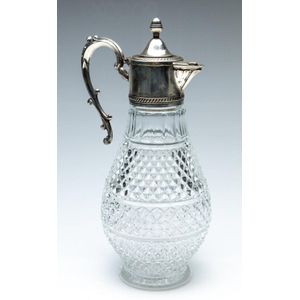
Victorian Silverplated English Claret Jug (32cm)
A Victorian silverplated English claret jug, height 32 cm
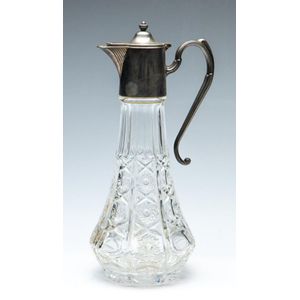
English Silverplated Claret Jug, Early 20th Century, 30 cm Height
An early 20th century English claret jug with silverplated spout and handle, height 30 cm
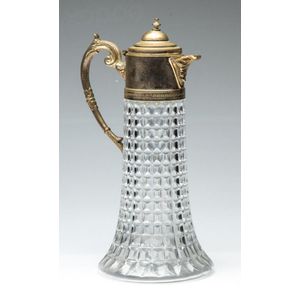
Etched Glass Claret Jug with Silverplate - 35cm Height
A large silverplated and glass claret jug with etched work, height 35 cm
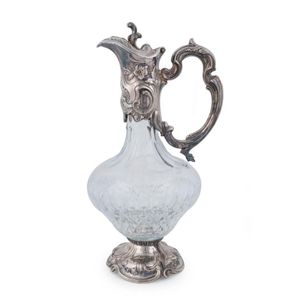
English Crystal Claret Jug with Silver Plating (10 words)
An English claret jug, cut crystal with silver plated marks, 20th century, 30 cm high
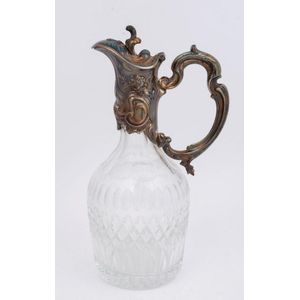
English Crystal Claret Jug with Silver Mount, 20th Century
Whitehill English crystal claret jug with silver plated mount, 20th century, 28 cm high
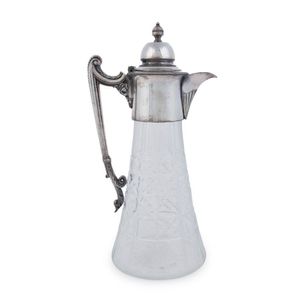
19th Century English Crystal Claret Jug with Silver Mount
An antique English claret jug, hobnail cut crystal with silver plated mount, 19th century, 30 cm high
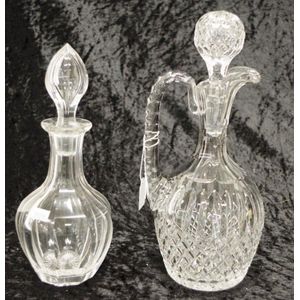
Crystal Spirit Decanters - Early Bottle and Claret Jug Forms
Two good cut crystal spirit decanters, including: early bottle form, height 25 cm and another claret jug form decanter marked for Webb and Corbett, height 29 cm
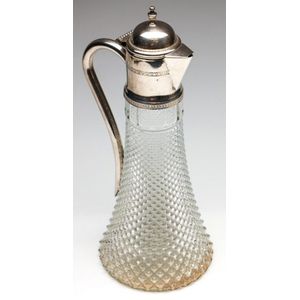
Silverplated Cut Glass Claret Jug - 35cm Height
A silverplated and cut glass claret jug, height 35 cm
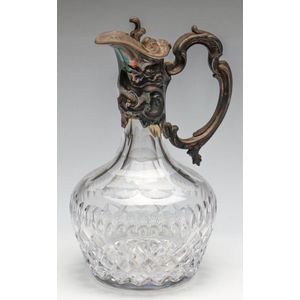
Silverplated Crystal Claret Jug - 26cm Height
A silverplated claret jug with cut crystal body, height 26 cm
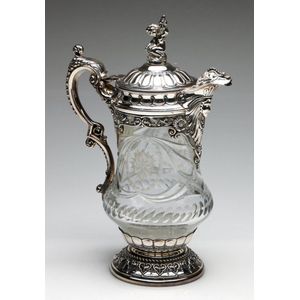
Whitehill Silverplate and Cut Glass Claret Jug
An ornate Whitehill silverplate and cut glass claret jug, height 34.5 cm
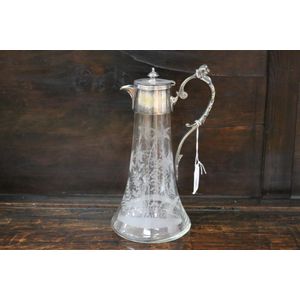
Victorian silver plated claret jug with wheel cut decoration
Antique silver plated Victorian claret jug, wheel cut and etched decoration, 28 cm high
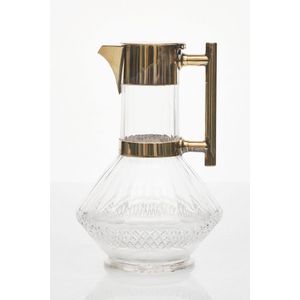
Dresser's Claret Jug with Gilt-Silver Mounts
After Christopher Dresser (British, 1834-1904), silver plated and cut-glass claret jug, designed c. 1880, gilt-silver plated mounts, stamped 'Mappin Brothers' and numbered, height 22 cm. Provenance: Private Collection, Sydney
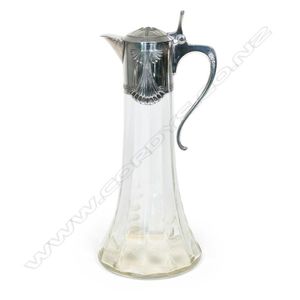
WMF Art Nouveau Silver Plate Claret Jug
A WMF Art Nouveau silver plate and glass claret jug, stamped to the handle. Height 31 cm
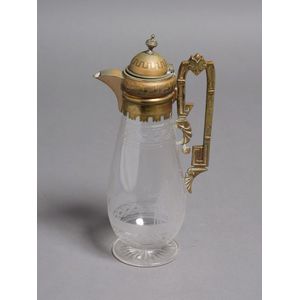
Cricket Engraved Claret Jug and Silver Trinket Box Set
A claret jug with metal mounts, engraved with a cricketing scene; together with a trinket box with silver top, marked 800, not illustrated, the claret jug, height 33 cm; the box, 9 x 9 x 7.5 cm
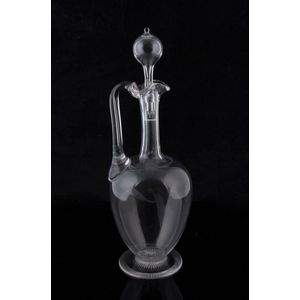
1860 English Glass Claret Jug with Stopper
An antique English glass claret jug with stopper, circa 1860, 32 cm high
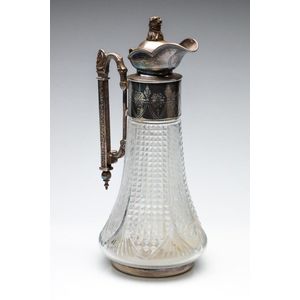
Crystal Claret Jug with Bear Finial
A silverplated and cut crystal claret jug with bear finial, height 32 cm
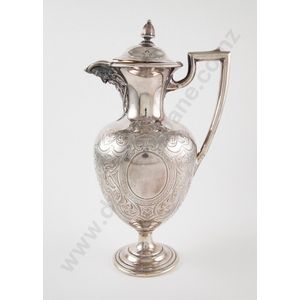
Late Victorian Wine Ewer with Bacchus Mask Spout
Late Victorian S/P wine ewer footed baluster shape the lid with acorn shaped finial, Bacchus mask spout and engraved scrolls and cartouche, 32 cm height
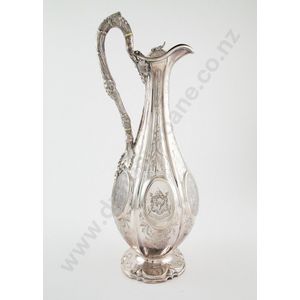
Victorian Wine Ewer with Engraved Crest and Branch Handle
Victorian S/P wine ewer elongated octagonal baluster form with naturlastic branch handle, the panels with oval engraved crest, and foliage, 37.5 cm height
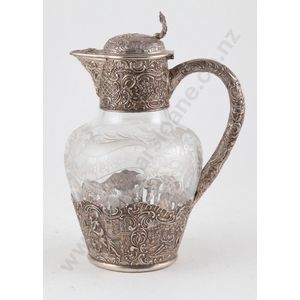
Dutch Silver Wine Ewer with Engraved Glass Body
Late 19th century Dutch silver mounted wine ewer baluster shape, with hinged dome lid and scroll handle, foliate engraved glass body the lower half overlaid with pierced silver depicting musical and other figures, 21 cm height
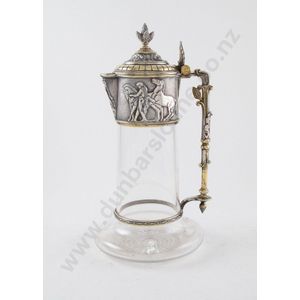
Victorian Cut Glass Claret Jug with Greek Equestrian Figures
Victorian cut glass claret jug the s/p and gilded mount with pine cone finial and cast in low relief with classical Greek equestrian figures, 28.5 cm height
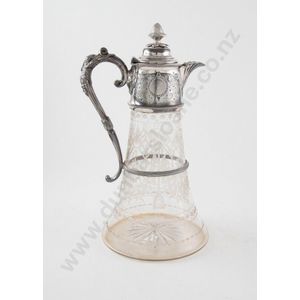
Engraved Victorian Claret Jug with Pineapple Finial
Victorian S/P & cut glass claret jug the domed lid with pineapple finial, the tapering body with engraved decoration, 29 cm height
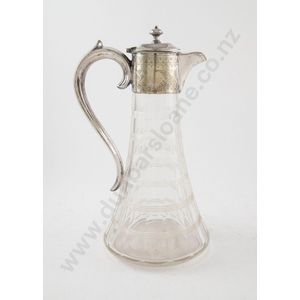
Victorian Cut Glass Claret Jug with Urn Finial
Victorian S/P cut glass claret jug the lid with urn finial, the tapering faceted body with 6 lines of engraved bands, 27.5 cm height
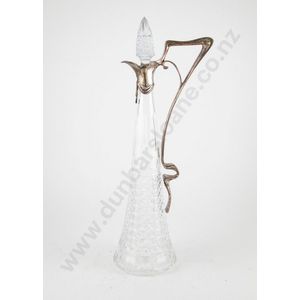
Art Nouveau Claret Jug with Faceted Design
An elegant Art Nouveau WMF style claret jug with faceted and hobnail cut elongated tapering body and star cut base and stylised s/p scroll handle and conical stopper, 46 cm height
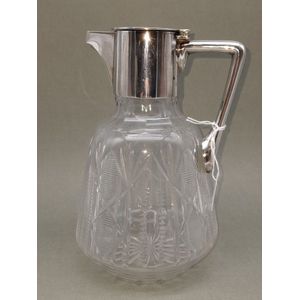
Victorian Cut Crystal Claret Jug with Silver Mount
Cut crystal claret jug, late Victorian with silver plated mount, height 19 cm
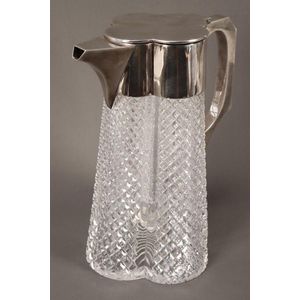
Grinsell & Sons Crystal Claret Jug with Silverplate Handle
Quality silverplate and crystal claret jug, by John Grinsell and Sons, the crystal body of quatrefoil form with an angled silverplate handle, terminating at a silverplate spout and hinged quatrefoil cover, the cover opening to reveal a pullout cylindrical…
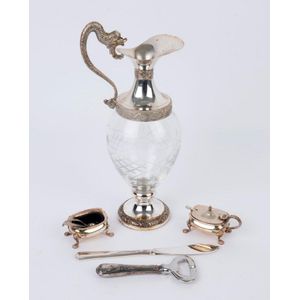
Italian Silver Plate Etched Glass Wine Jug with Serpent Handle
An Italian silver plate mounted etched glass wine jug with serpent handle, mid 20th century, 30 cm high (lacks stopper), plus several other plated items.
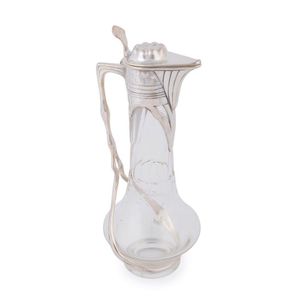
German Art Nouveau Crystal Claret Jug with Silver Mounts
A German Art Nouveau crystal claret jug with silver plated mounts, most likely by Orivit, circa 1895, 30 cm high
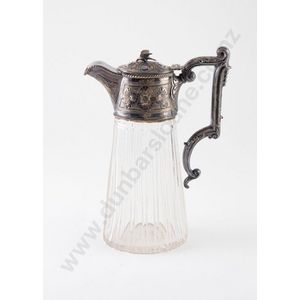
Silver Plate Claret Jug with Floret Cartouche and Handle
Edwardian silver plate mounted cut glass claret jug finely cut ribbed glass body with embossed floret cartouche mount and handle
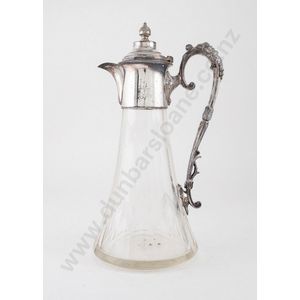
Faceted Cut Glass Claret Jug with Silver Handle
Art Deco cut glass claret jug tapering faceted body with engraved twin bands, silver plate handle and mount
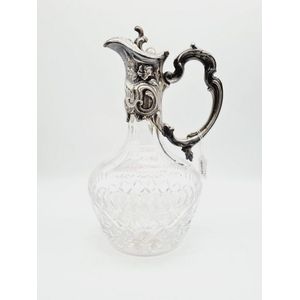
Ornate Silverplated and Cut Crystal Claret Jug
Crystal claret jug, beautiful Whitehill silverplated ornate top and cut crystal base
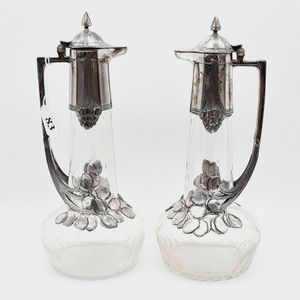
Art Nouveau Silver-Plated Claret Jugs (Pair)
Pair of WMF Art Nouveau claret jugs, silver plated over crystal, height 24 cm
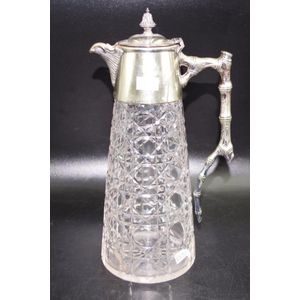
Silver Plate & Cut Crystal Claret Jug with Wear
Silver plate & cut crystal claret jug height 27 cm approx. Wear to the plate.
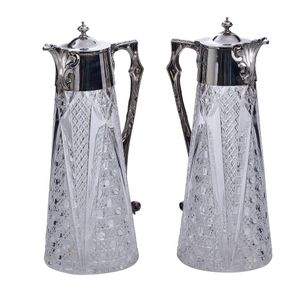
Victorian Silver Claret Jugs with Elaborate Crystal Bodies
A pair of Victorian silver mounted claret jugs, maker's mark of James Dixon & Sons, Sheffield 1899, with elaborate hobnail and lattice cut crystal bodies, height 28 cm
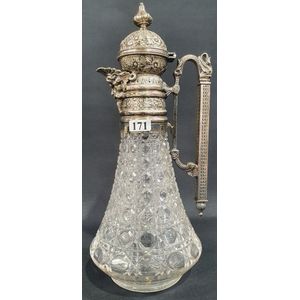
Victorian Cut Crystal Claret Jug with Mask Spout
A Victorian silver plated and cut crystal claret jug, with mask spout. Height 33 cm.
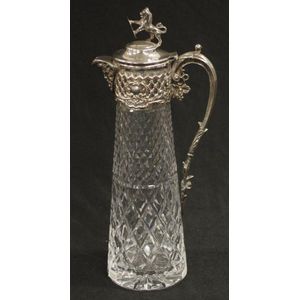
Silver Plate & Crystal Claret Jug with Lion Finial
Good silver plate & crystal claret jug with lion rampant finial. 32 cm high.
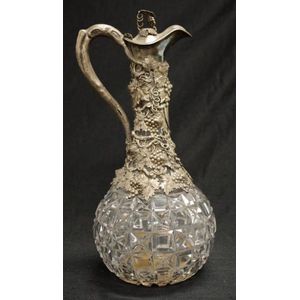
Crystal and Silver Claret Jug with Grapevine Decoration
Silver plated and crystal claret jug with pierced grapevine decoration, 31 cm high
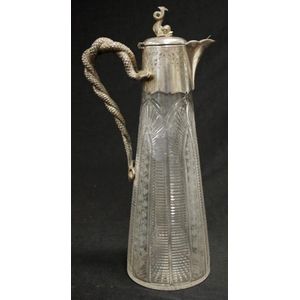
Snake-handled Silver Plated Cut Glass Claret Jug
Antique silver plated and cut glass claret jug with figural snake handle, 32 cm high
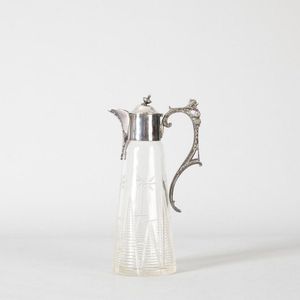
Crystal and Silver Claret Jug with Lid Damage (27cm)
A cut crystal and silver plate claret jug, note damage to lid, height 27 cm
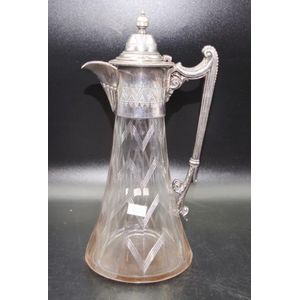
Victorian Silver Plate & Cut Crystal Claret Jug
Victorian silver plate & cut crystal claret jug height 29 cm
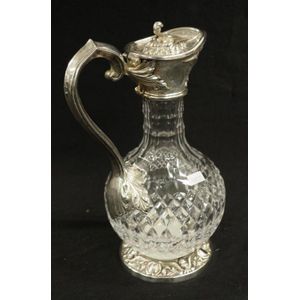
Cherub Claret Jug
Whitehill silver plate & cut crystal claret jug with in relief cherub decoration, height
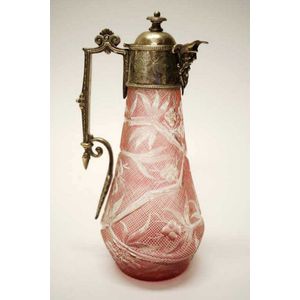
Ruby Flash Cut Glass Claret Jug with Silver Fittings
Antique ruby flash cut glass claret jug with silver plated fittings, 28.5 cm high
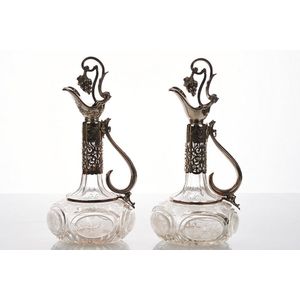
Silver-plate Mounted Cut Crystal Claret Jugs (Pair)
Pair of Silver-plate mounted cut crystal claret jugs, c. 1900, the reticulated mounts engraved with scrolls, the lid with weighted mechanism modelled as a bunch of grapes, with scroll handle (2), height 33 cm. Provenance: Private Collection, Sydney
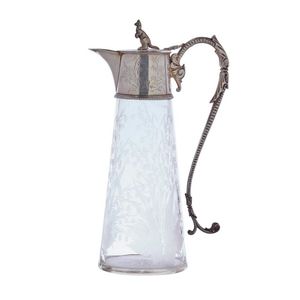
Etched Crystal & Silverplated Claret Jug with Kangaroo Finial
An Edwardian etched crystal and silverplated claret jug, the body of the jug engraved with flowers and leaves, the silverplated handle and engraved top with a kangaroo finial, circa 1910, height 27 cm
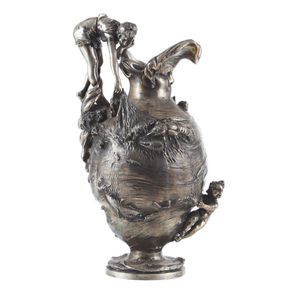
Art Nouveau Wine Ewer with Aquatic Scene
An Art Nouveau wine ewer, attributed to WMF, in the style of Albert Mayer (1867-1944), circa 1890, the jug finely decorated with an aquatic scene, of female and putto casting a net into the sea. No factory marks visible, stamped 22 to base. 33.5 cm total…
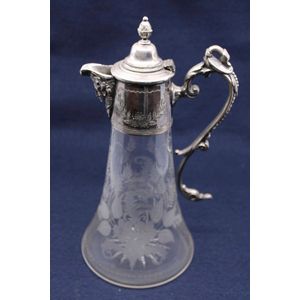
Etched Glass and Silver Plate Claret Jug (19th Century)
19th century etched glass and silver plate claret jug 29 cm high, 14 cm wide,
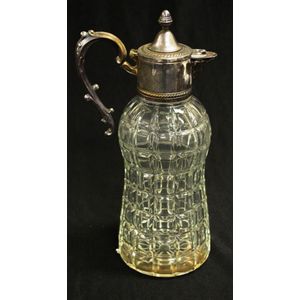
Crystal Claret Jug with Silver Plate Handle and Cover
Vintage silver plate & crystal claret jug silver plate handle and cover, to crystal jug, height 32 cm
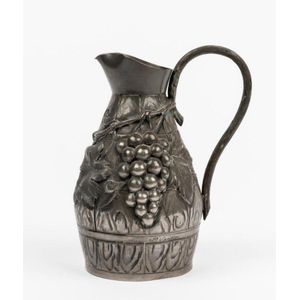
Pewter Grape and Vine Wine Ewer by P. VANHO
A pewter grape and vine decorated wine ewer, signed to body P. VANHO, 19 cm high
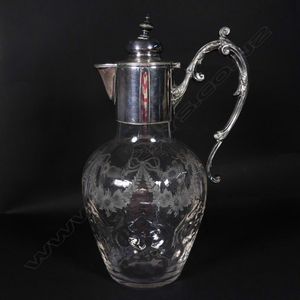
Edwardian Crystal and Silver Plate Claret Jug
An Edwardian crystal and silver plate claret jug, the mounts with acanthus capped handle, the ovoid body etched with ribbon and floral swags. Height 25 cm
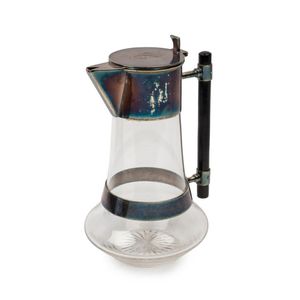
19th Century Dresser-style Silver Plated Claret Jug
Christopher Dresser style silver plated claret jug, 19th century, 23.5 cm high
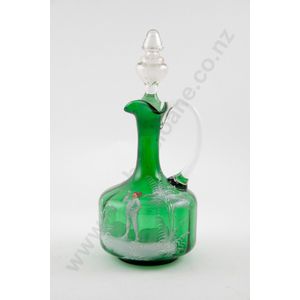
Victorian Enamel Painted Claret Jug with Boy Design
Victorian Mary Gregory claret jug green glass enamel painted with young boy 28 cm height

19th Century Silver Plate Collection
Collection of silver plate pieces, 19th century and later, comprising Old Sheffield Plate entre dish and cover, Hardy Brothers claret jug, twin handled tray, basket, salver and pair of pierced dishes (13) width 66 cm, (tray). Provenance: The Estate of…

Amethyst Glass Claret Jug with Silverplate Lid and Handle
Amethyst glass claret jug with a clear celery handle and silverplate lid, height 20 cm
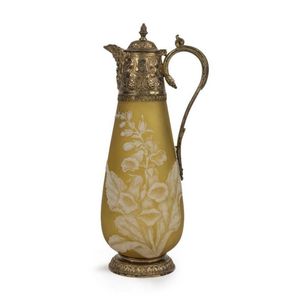
Silver Mounted Cameo Glass Claret Jug with Foxgloves
A rare silver mounted cameo glass claret jug attributed to Thomas Webb & Sons maker's mark Joseph Cook & Son, Birmingham, 1880 the tapering yellow ground body overlaid in opaque white, finely carved with foxgloves and leafage, with a Bacchus mask spout…
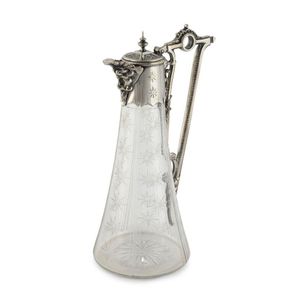
Antique English Crystal Claret Jug with Silver Plating, 1880
An antique English claret jug, engraved crystal with silver plated mounts, circa 1880, 27 cm high
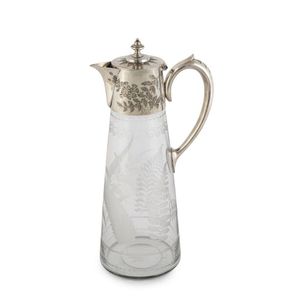
Antique Fern Etched Claret Jug, 1875
An antique claret jug, silver plate and glass with finely etched fern decoration, circa 1875, 30 cm high
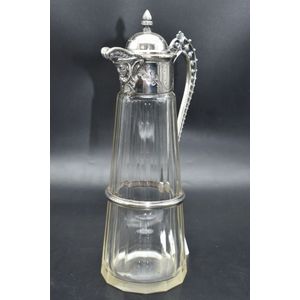
Victorian Silverplate Claret Jug with Glass Mount (29cm)
Victorian silverplate mount glass claret jug, height 29 cm
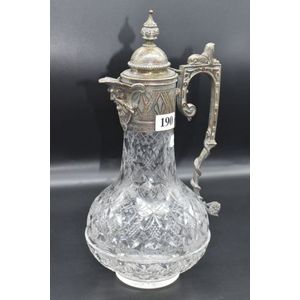
Crystal and Silver Claret Jug with Engraved Decorations
An antique cut crystal and silver plate claret jug with engraved decorations and mask shape spout





 Loading more...
Loading more...